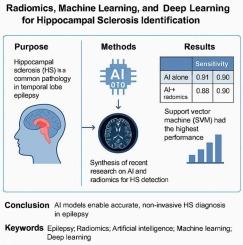Radiomics, machine learning, and deep learning for hippocampal sclerosis identification: a systematic review and diagnostic meta-analysis
IF 2.3
3区 医学
Q2 BEHAVIORAL SCIENCES
引用次数: 0
Abstract
Purpose
Hippocampal sclerosis (HS) is the primary pathological finding in temporal lobe epilepsy (TLE) and a common cause of refractory seizures. Conventional diagnostic methods, such as EEG and MRI, have limitations. Artificial intelligence (AI) and radiomics, utilizing machine learning and deep learning, offer a non-invasive approach to enhance diagnostic accuracy. This study synthesized recent AI and radiomics research to improve HS detection in TLE.
Methods
PubMed/Medline, Embase, and Web of Science were systematically searched following PRISMA-DTA guidelines until May 2024. Statistical analysis was conducted using STATA 14. A bivariate model was used to pool sensitivity (SEN) and specificity (SPE) for HS detection, with I2 assessing heterogeneity.
Results
Six studies were included. The pooled sensitivity and specificity of AI-based models for HS detection in medial temporal lobe epilepsy (MTLE) were 0.91 (95 % CI: 0.83–0.96; I2 = 71.48 %) and 0.9 (95 % CI: 0.83–0.94; I2 = 69.62 %), with an AUC of 0.96. AI alone showed higher sensitivity (0.92) and specificity (0.93) than AI combined with radiomics (sensitivity: 0.88; specificity: 0.9). Among algorithms, support vector machine (SVM) had the highest performance (SEN: 0.92; SPE: 0.95), followed by convolutional neural networks (CNN) and logistic regression (LR).
Conclusion
AI models, particularly SVM, demonstrate high accuracy in detecting HS, with AI alone outperforming its combination with radiomics. These findings support the integration of AI into non-invasive diagnostic workflows, potentially enabling earlier detection and more personalized clinical decision-making in epilepsy care—ultimately contributing to improved patient outcomes and behavioral management.

放射组学、机器学习和深度学习在海马硬化识别中的应用:一项系统综述和诊断荟萃分析
目的海马硬化(HS)是颞叶癫痫(TLE)的主要病理表现,是难治性癫痫发作的常见原因。传统的诊断方法,如脑电图和核磁共振成像,有局限性。人工智能(AI)和放射组学,利用机器学习和深度学习,提供了非侵入性的方法来提高诊断的准确性。本研究综合了近年来人工智能和放射组学的研究成果,以提高TLE的HS检测水平。方法按照PRISMA-DTA指南系统检索spubmed /Medline、Embase和Web of Science,检索截止至2024年5月。采用STATA 14进行统计分析。采用双变量模型对HS检测的敏感性(SEN)和特异性(SPE)进行汇总,I2评估异质性。结果共纳入6项研究。人工智能模型检测内侧颞叶癫痫(MTLE) HS的总敏感性和特异性为0.91 (95% CI: 0.83-0.96;I2 = 71.48%)和0.9 (95% CI: 0.83-0.94;I2 = 69.62%), AUC为0.96。人工智能单用的敏感性(0.92)和特异性(0.93)均高于人工智能联合放射组学(敏感性:0.88;特异性:0.9)。在算法中,支持向量机(SVM)的性能最高(SEN: 0.92;SPE: 0.95),其次是卷积神经网络(CNN)和逻辑回归(LR)。结论人工智能模型,特别是支持向量机,在检测HS方面具有较高的准确性,单独使用人工智能优于与放射组学的结合。这些发现支持将人工智能整合到非侵入性诊断工作流程中,有可能在癫痫治疗中实现更早的发现和更个性化的临床决策,最终有助于改善患者预后和行为管理。
本文章由计算机程序翻译,如有差异,请以英文原文为准。
求助全文
约1分钟内获得全文
求助全文
来源期刊

Epilepsy & Behavior
医学-行为科学
CiteScore
5.40
自引率
15.40%
发文量
385
审稿时长
43 days
期刊介绍:
Epilepsy & Behavior is the fastest-growing international journal uniquely devoted to the rapid dissemination of the most current information available on the behavioral aspects of seizures and epilepsy.
Epilepsy & Behavior presents original peer-reviewed articles based on laboratory and clinical research. Topics are drawn from a variety of fields, including clinical neurology, neurosurgery, neuropsychiatry, neuropsychology, neurophysiology, neuropharmacology, and neuroimaging.
From September 2012 Epilepsy & Behavior stopped accepting Case Reports for publication in the journal. From this date authors who submit to Epilepsy & Behavior will be offered a transfer or asked to resubmit their Case Reports to its new sister journal, Epilepsy & Behavior Case Reports.
 求助内容:
求助内容: 应助结果提醒方式:
应助结果提醒方式:


